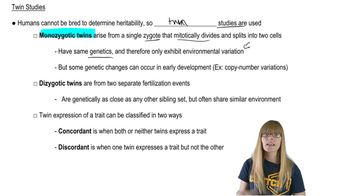The ABO and MN blood groups are shown for four sets of parents (1 to 4) and four children (a to d). Recall that the ABO blood group has three alleles: I^A, I^B and i. The MN blood group has two codominant alleles, M and N. Using your knowledge of these genetic systems, match each child with every set of parents who might have conceived the child, and exclude any parental set that could not have conceived the child. <>
Provide a definition and an example for each of the following terms:
concordance of twin pairs
 Verified step by step guidance
Verified step by step guidance
Verified video answer for a similar problem:
Key Concepts
Concordance Rate

Types of Twins

Environmental Influences

The wild-type color of horned beetles is black, although other colors are known. A black horned beetle from a pure-breeding strain is crossed to a pure-breeding green female beetle. All of their F₁ progeny are black. These F₁ are allowed to mate at random with one another, and 320 F₂ beetles are produced. The F₂ consists of 179 black, 81 green, and 60 brown. Use these data to explain the genetics of horned beetle color.
Provide a definition and an example for each of the following terms:
additive genes
Provide a definition and an example for each of the following terms:
multifactorial inheritance
Provide a definition and an example for each of the following terms:
polygenic inheritance
Provide a definition and an example for each of the following terms:
quantitative trait locus
